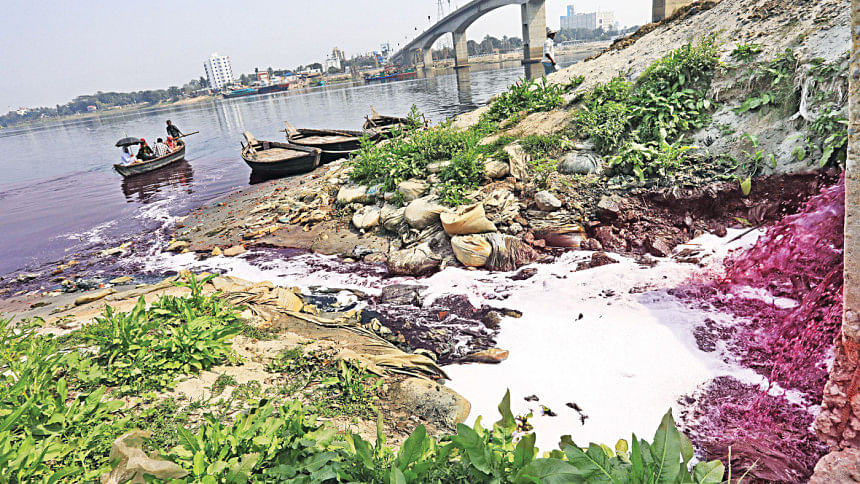Int’l day of action for rivers: Shitalakkhya a deathbed for fish now

Sanjit Babu, from Baghia village in Gazipur's Kapasia upazila, has been running a tea stall at Narayanpur market on the bank of the Shitalakshya river for the last four years.
Until five years ago, he used to fish in the river for a living. Both his father and grandfather were also fishermen. But the depletion of the fish stock in the river due to industrial pollution forced them all to turn to other professions.
His father now works as a farm labourer.
"There is hardly any fish in the river now, so I cannot catch any. Now, I buy dry fish from different places and sell them for livelihood," said Akhil Babu, Sanjit's grandfather.
Like these three generations of the Babus, many fishermen along the bank of the Shitalakshya in Gazipur have left fishing and taken up other occupations, as untreated industrial waste continues to flow into the river unabated, turning the water into a toxic, pitch-black substance.
Visiting different areas in Gazipur recently, The Daily Star found that the waste from numerous factories flowing into the Shitalakshya from Bhaluka through the Matikata river and Sutia river in Bormi area of Sreepur, Gazipur.
The 110km long Shitalakshya, which flows along different parts of Gazipur, Narsingdi, Narayanganj and Dhaka, was once the mainstay for fishermen.
Even some years ago, different species of fish, such as Rui, Katla, Kalbaush, Gutum, Boal, Puti, Shrimp, Shail, Chapila and Baira, were plentiful in the river, locals say.
Rafiqul Islam, a hotelier in Bormi Bazar, said, various species of dead fish are now seen floating in the river.
"Many fishermen from whom I used to buy fish have abandoned fishing and turned to various other occupations," he said.
According to the Department of Environment (DoE), there are 350 dyeing and washing factories and hundreds of readymade garment factories in Gazipur. Of them, 617 factories have effluent treatment plants (ETPs).
The Upazila Fisheries Department say waste released by different factories is the main reason behind the decline in the fish stock in the river.
Md Ashrafullah, senior upazila fisheries officer at Kapasia, said aquatic life, including fish, is near-extinct due to the pollution.
Nayan Mia, deputy director of the DoE in Gazipur, said there are very few factories without ETPs in Gazipur.
"But even those that have the ETPs are polluting the environment and rivers. Factories are not using ETPs properly. They keep the ETPs operational only when we visit factories and stop those after we leave. As a result, billions of litres of liquid waste end up in the river," he told The Daily Star.
Due to the closure of ETPs in the factories at night, liquid waste from Bhaluka and Mawna areas flows into the Shitalakshya through the Sutia river and Matikata river, he added.
"When dyeing factories run along a river, it is very difficult to protect the river from pollution."
Sharif Jamil, an environmentalist, blamed unplanned industrialisation along the river banks for destruction and pollution of rivers.
He also lamented the fact that the government did not adequately empower the River Commission to take action against river polluters.
"The government needs to think about how to save rivers. Without taking tough actions, including shutting down of the polluting factories, our rivers cannot be saved," said Nayan Mia of the DoE, Gazipur.

 For all latest news, follow The Daily Star's Google News channel.
For all latest news, follow The Daily Star's Google News channel. 








Comments